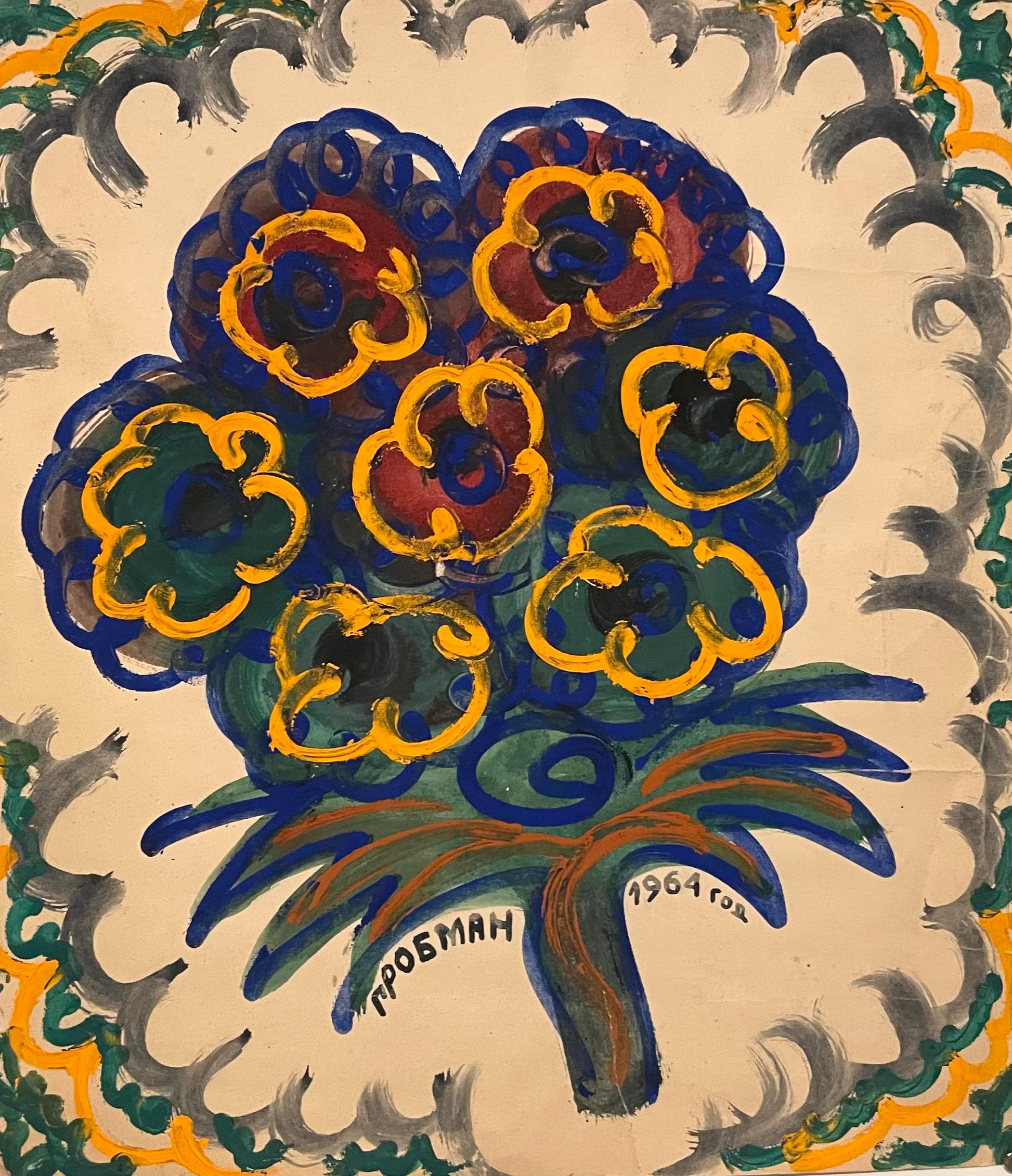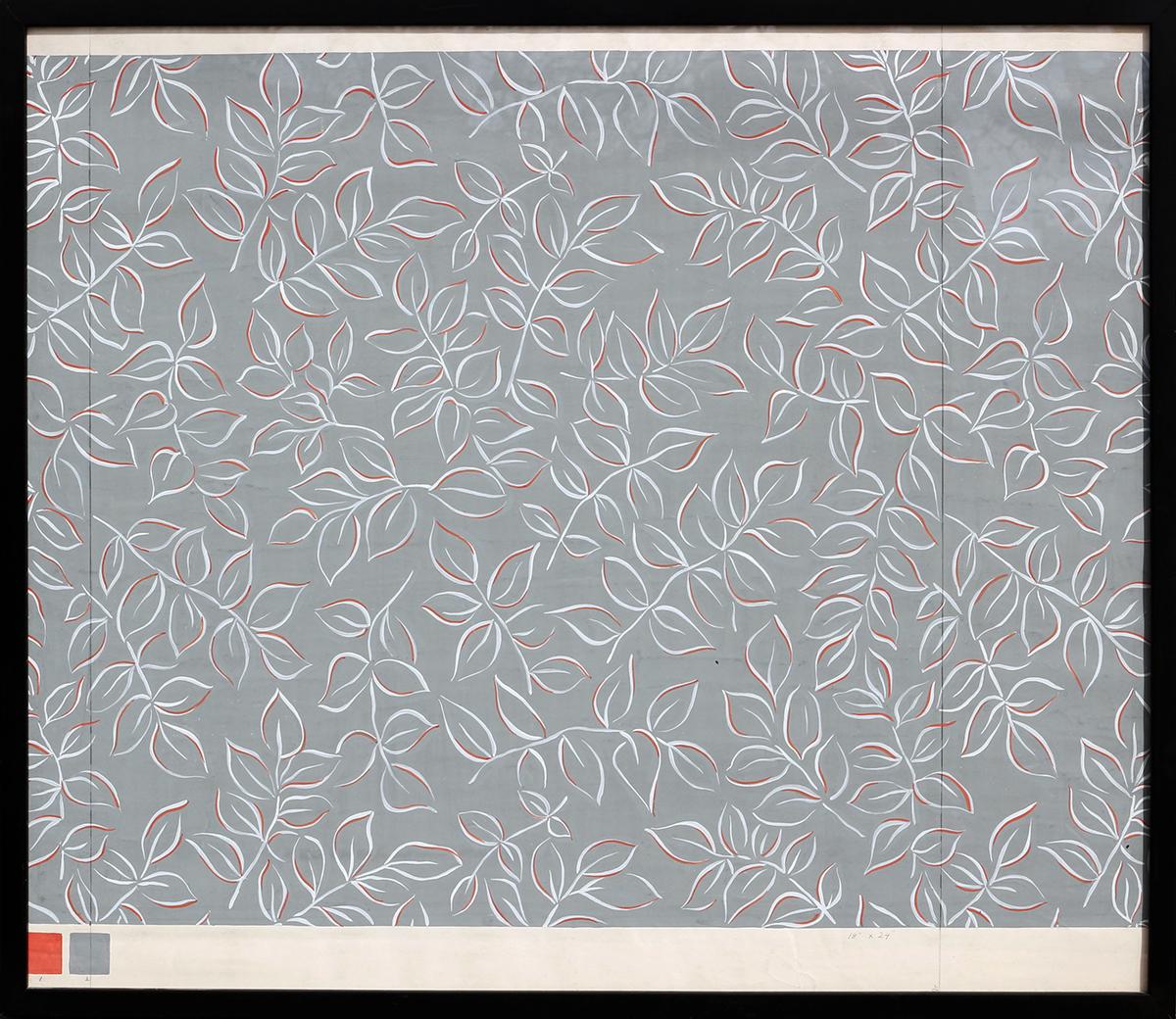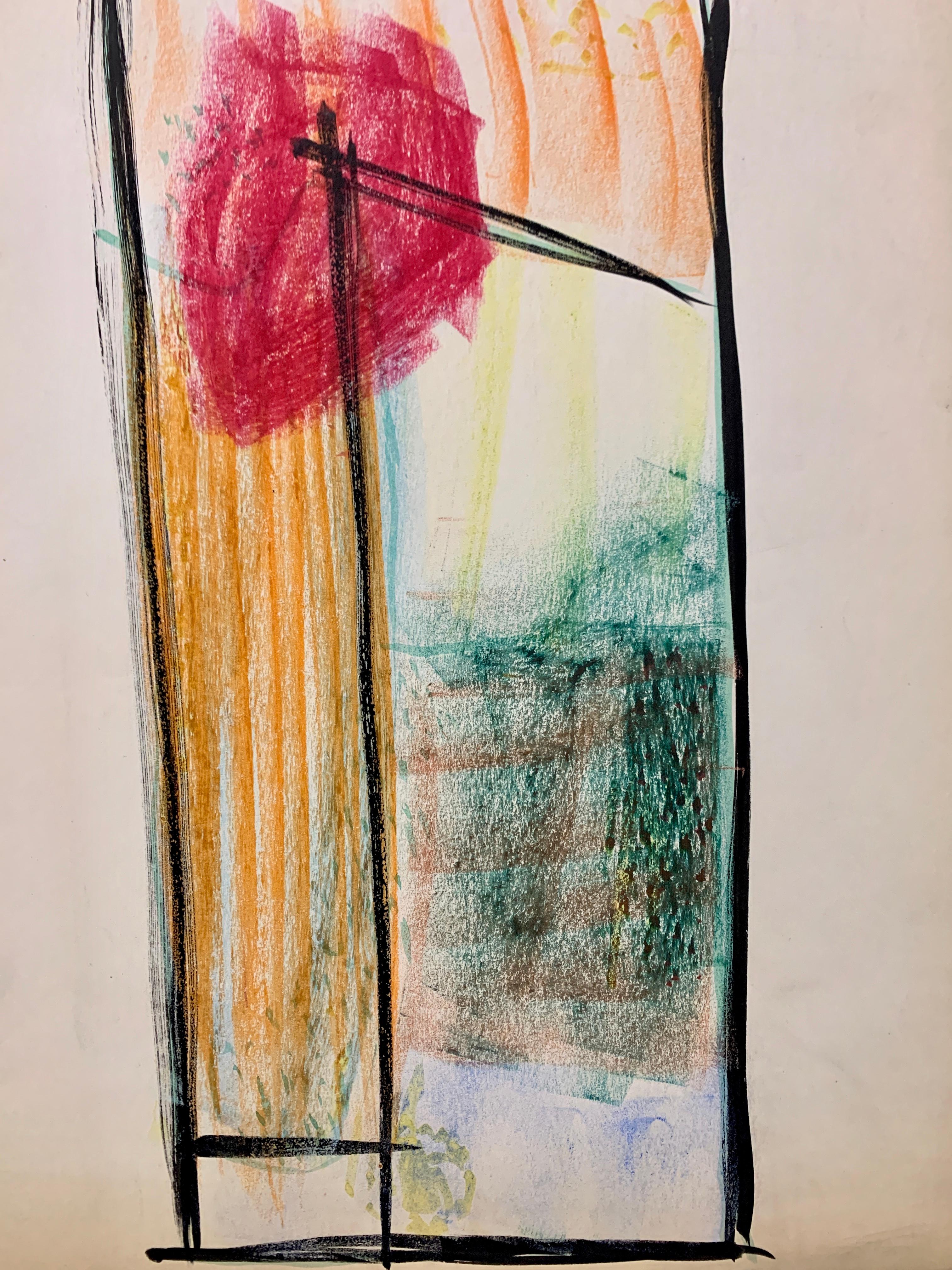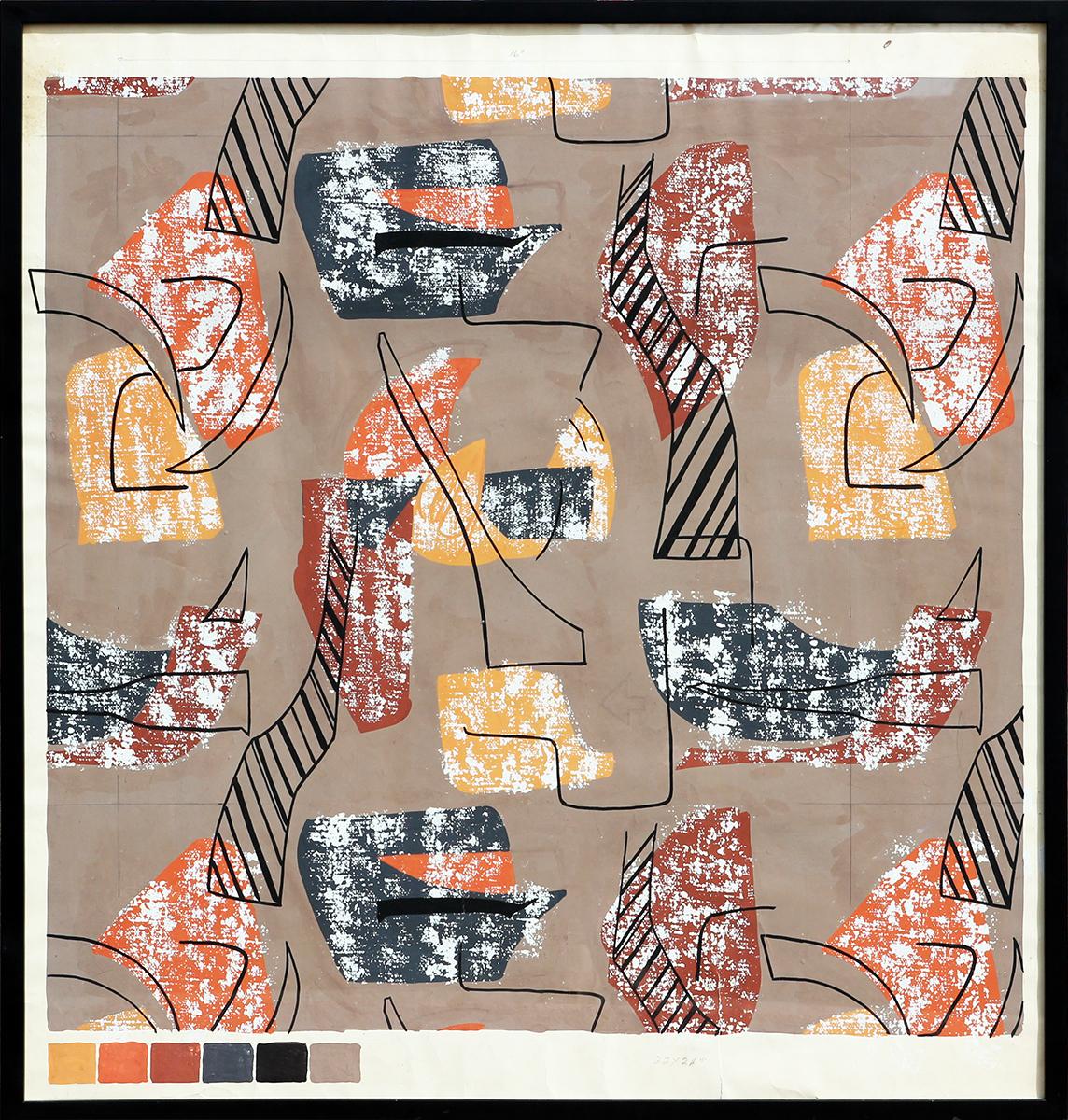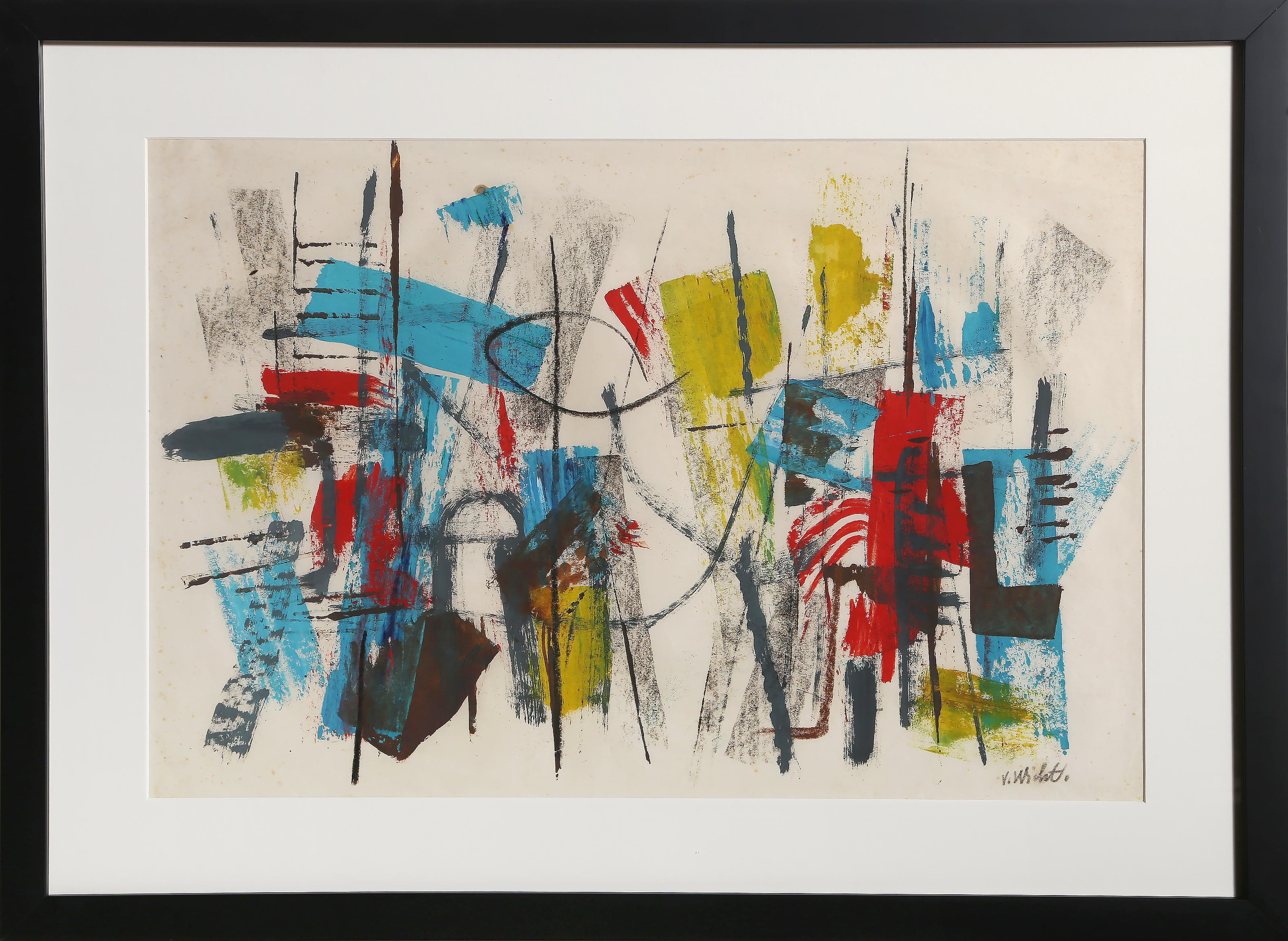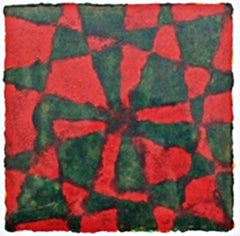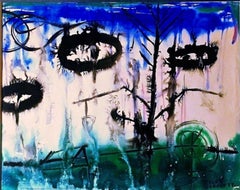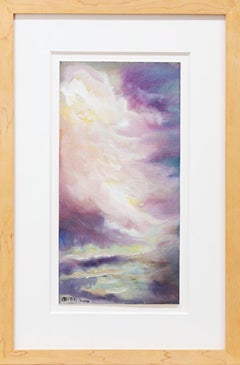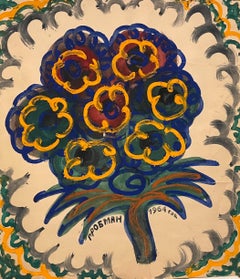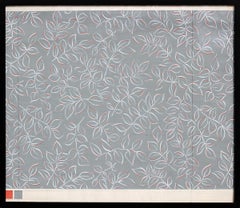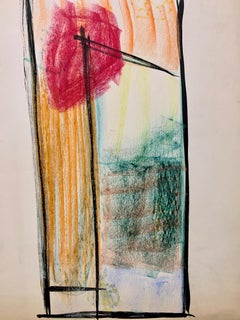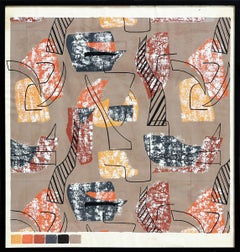Items Similar to Unique signed Mid Century Modern Abstract painting by renowned American painter
Want more images or videos?
Request additional images or videos from the seller
1 of 7
Thomas Brownell EldredUnique signed Mid Century Modern Abstract painting by renowned American painter1941
1941
About the Item
THOMAS BROWNELL ELDRED
Untitled Mid Century Modern Abstraction, 1941
Gouache on paper
Hand signed and dated 1941 on the front
14 3/4 × 21 inches
Unique
Provenance: Acquired from the estate of Thomas Brownell Eldred
Accompanied by Certificate of Guarantee from Alpha 137 Gallery
Unframed
This gorgeously colored gouache painting on thick paper was created at a time when the Guggenheim Museum (Museum of Non-Objective Painting) was collecting Eldred's work, alongside works by Kandinsky and Bauer. Unique works like this by Eldred are very desirable in the marketplace. It typifies the artist's eclectic style, reflecting his involvement with Surrealism and the New York School. It also highlights Eldred’s excellent draftsmanship through the characteristic bright colors and patterns that he developed during his time as a naval wood pattern maker in the merchant marines.
More about Thomas Brownell Eldred
Thomas Brownell Eldred (1903-1993) was born in Michigan and was admitted to the prestigious Art Institute of Chicago. After serving in the Merchant Marines, he attended The Art Students League in New York with Thomas Hart Benton. In the 1930s, he was accepted into the famous artist’s colony Yaddo, but instead took a position teaching at the Brooklyn Museum of Art, funded through the WPA’s Federal Art Project, which established to provide struggling artists with economic support during The Great Depression. Eldred worked amongst other WPA artists, such as, Ben Shahn, Mark Rothko and Philip Guston. In Brooklyn, Eldred met the innovative print-maker Werner Drewes, who studied at Bauhaus with major modernists Johannes Itten, Paul Klee, Lyonel Feininger and Wassily Kandinsky. Drewes also served as Director of the Graphic Art Project of the WPA in New York and was a founding member of the influential American Abstract Artists (AAA) group. In the late 30s and 40s, when this painting was created, the Guggenheim's acquired Eldred's work for their new Museum of Non-Objective painting (now the Guggenheim Museum), which focused on international abstraction.
- Creator:Thomas Brownell Eldred (1903 - 1993, American)
- Creation Year:1941
- Dimensions:Height: 14.75 in (37.47 cm)Width: 21 in (53.34 cm)
- Medium:
- Movement & Style:
- Period:
- Condition:Good vintage condition; the gradations in color & darkening in the color bands are part of the artist's gouache technique; minor waviness (see photos).
- Gallery Location:New York, NY
- Reference Number:1stDibs: LU1745213290212
About the Seller
5.0
Platinum Seller
Premium sellers with a 4.7+ rating and 24-hour response times
Established in 2007
1stDibs seller since 2022
418 sales on 1stDibs
Typical response time: 2 hours
- ShippingRetrieving quote...Shipping from: New York, NY
- Return Policy
Authenticity Guarantee
In the unlikely event there’s an issue with an item’s authenticity, contact us within 1 year for a full refund. DetailsMoney-Back Guarantee
If your item is not as described, is damaged in transit, or does not arrive, contact us within 7 days for a full refund. Details24-Hour Cancellation
You have a 24-hour grace period in which to reconsider your purchase, with no questions asked.Vetted Professional Sellers
Our world-class sellers must adhere to strict standards for service and quality, maintaining the integrity of our listings.Price-Match Guarantee
If you find that a seller listed the same item for a lower price elsewhere, we’ll match it.Trusted Global Delivery
Our best-in-class carrier network provides specialized shipping options worldwide, including custom delivery.More From This Seller
View AllLyre Bird (Design for the cover of Poetry London), 1943, Ink, gouache and pastel
Located in New York, NY
Ceri Richards
Lyre Bird (Design for the cover of Poetry London), 1943
Ink, gouache and pastel on paper
Bears original Jonathan Clark & Co. label on the back of the frame
Unique
Frame...
Category
1940s Modern Abstract Paintings
Materials
Oil Pastel, Ink, Gouache
Unique signed gouache on linen painting (Framed) by renowned Provincetown artist
Located in New York, NY
James Balla
Untitled gouache painting, 1992
Mixed Media Oil on Linen
Signed and dated on the front of the work; the verso of the frame bears the UFO (Albert Merola) gallery label.
F...
Category
1990s Abstract Geometric Abstract Paintings
Materials
Mixed Media, Oil, Gouache, Pencil
Untitled Abstract Expressionist painting on paper mid century modern art
By Rolph Scarlett
Located in New York, NY
Rolph Scarlett
Untitled Abstract Expressionist Painting, ca. 1960
Gouache, Ink, Watercolor on Paper . Hand signed, with original Jonas Aarons Gallery label
23 × 18 3/4 inches
Signed ...
Category
Mid-20th Century Abstract Expressionist Abstract Drawings and Watercolors
Materials
Watercolor, Gouache
Play of Angels, unique signed watercolor & gouache color field painting Framed
By Jules Olitski
Located in New York, NY
Jules Olitski
Play of Angels, 2000
Watercolor and gouache on all-rag paper
Signed and dated 2000 by the artist on the front
Frame included (elegantly floated and framed in light wood...
Category
Early 2000s Color-Field Abstract Drawings and Watercolors
Materials
Mixed Media, Watercolor, Gouache, Rag Paper, Permanent Marker
Pillar of Zen #124, unique signed gouache painting Andre Zarre Gallery, 1959
By Charmion von Wiegand
Located in New York, NY
Charmion von Wiegand
Pillar of Zen #124, 1959
Gouache on paper painting
Hand signed, titled and dated on the front
Unique
Provenance: Andre Zarre Gallery, with label verso
(Estate of renowned gallerist Andre Zarre, ne Andre Sowulewski)
Measurements:
Framed
26.5 inches vertical by 25.5 horizontal by 2 inches
Artwork:
21 inches vertical by 22 inches horizontal
Mid century modern, geometric, spiritual abstraction, mystical
The Estate of the celebrated artist Charmion Von Wiegand has been represented exclusively by Michael Rosenfeld Gallery since 1998.
From March 3 to August 13, 2023, Charmion Von Wiegand was the subject of an acclaimed retrospective at the Kunstmuseum Basel, and she has received major attention in the price, including a June, 2023 ArtNews feature entitled, "Who Was Charmion von Wiegand and Why Is She Important?". Her work was also featured in a solo presentation by Rosenfeld Gallery at the New York Art Show held at the Park Avenue Armory, which also received critical acclaim.
Artists Biography - courtesy of Michael Rosenfeld Gallery:
Known for her vibrant, geometric paintings that originate a deeply personal language of spiritual enlightenment expressed through a constructivist mode of abstraction, Charmion von Wiegand (1896–1983) was born in Chicago but spent much of her childhood traveling. The daughter of a journalist for Hearst, von Wiegand eventually settled in New York in 1915 to attend Barnard College and Columbia University, where she took classes at the School of Journalism while nurturing a growing interest in art history. In 1925, von Wiegand realized that she wanted to be an artist and set up a studio in Greenwich Village, teaching herself how to paint while pursuing a career as a journalist. In 1929, she secured a position in Moscow as a foreign correspondent for Hearst, the only woman at the desk at the time.
In 1932, von Wiegand returned to New York and married Russian émigré Joseph Freeman, who co-founded and edited the leftist journal New Masses. Von Wiegand began writing art criticism for New Masses as well as for other publications, including New Theatre, ARTnews, and Arts Magazine. When the Abstract American Artists (AAA) held their inaugural exhibition, von Wiegand reviewed it. An early champion of abstract art, von Wiegand became close friends with AAA founder Carl Holty. In 1941, Holty introduced von Wiegand to Piet Mondrian, who would have a profound impact on her art. Fascinated by Mondrian’s artistic philosophy, von Wiegand played a key role in the introduction of his work to American audiences, translating many of the Dutch artist’s writings into English and assisting in the composition of his influential article “Toward the True Vision of Reality” (1941). Through her friendship with Mondrian, von Wiegand re-kindled her interest in Theosophy (a religion established in the late 19th century that combines aspects of Hinduism, Buddhism, occultism, and esotericism) and embarked on an extended study of neoplasticism. In her artwork, she incorporated Mondrian’s iconic grid but rejected the constraints of pure neoplasticism and embraced a wide range of influences including surrealism and German expressionism.
In 1942, von Wiegand became a member of the AAA, exhibiting regularly with the group and eventually serving as its president from 1951 to 1953. In the late 1940s, sculptor and fellow AAA member Ibram Lassaw gave her a translation of The Secret of the Golden Flower: A Chinese Book of Life, which inspired von Wiegand to immerse herself in a study of Buddhist art. She began incorporating Buddhist motifs such as stupas and mandalas into her paintings, and her spiritual practice steadily intensified throughout the 1950s. In 1953, her husband gifted her a copy of the Taoist I Ching Book of Changes, a guide for divining meaning from randomly derived numbers arranged in a hexagram—a form the artist readily incorporated into her painting. Von Wiegand’s study of Theosophy also intensified over these years, bolstered by her increased access to the religion’s primary sources composed by the religion’s founders and their successors at the New York Theosophical Society’s library. Von Wiegand’s search for the sacred and transcendent ultimately led her to Tibetan Buddhism and, in 1967, von Wiegand met Khyongla Rato Rinpoche, a Gelugpa monk who had recently arrived in New York, who would mentor her spiritual study in the tradition of Mahayana Buddhism until her death. Her travels in the 1960s and 1970s took her to Tibet and India, where she had an audience with the Dalai Lama, who was living in exile in Dharamsala. Many works from these decades incorporate symbols and schematics drawn from Theosophical prismatic color charts, Chinese astrology and tantric yoga.
In 1978, she was the subject of a PBS documentary titled The Circle of Charmion von Wiegand, which was scored by Philip Glass. In 1980, von Wiegand was elected to the American Academy of Arts and Letters and in 1982, the Bass Museum of Art in Miami Beach (FL) organized her first retrospective exhibition. She died the following year in New York, bequeathing her estate to Khyongla Rato and the Tibet Center of New York. In 1998, Michael Rosenfeld Gallery became the sole representative of her estate and has presented her work in four solo and multiple group exhibitions. Recent notable exhibitions that have included her work are The Third Mind: American Artists Contemplate Asia (Solomon R. Guggenheim Museum, New York, NY, 2009) and Constructive Spirit: Abstract Art in South and North America (Newark Museum, NJ, 2010). In March 2023, the Kunstmuseum Basel (Switzerland) opened the first comprehensive museum retrospective of von Wiegand’s work in Europe.
Von Wiegand’s work is represented in numerous museum collections including the Addison Gallery of American Art, Phillips Academy (Andover, MA); Albright-Knox Art Gallery (Buffalo, NY); Arithmeum, University of Bonn (Germany); Birmingham Museum of Art (Alabama); Blanton Museum of Art, The University of Texas at Austin; Brooklyn Museum (NY); Carnegie Museum of Art (Pittsburgh, PA); The Cleveland Museum of Art (OH); Indianapolis Museum of Art (IN); Fondazione Marguerite Arp (Locarno, Switzerland); Museum of Fine Arts, Boston (Massachusetts); The Metropolitan Museum of Art (New York, NY); The Museum of Modern Art (New York, NY); Newark Museum of Art (New Jersey); Seattle Art Museum (WA); Smithsonian American Art Museum (Washington, DC); Walker Art Center (Minneapolis, MN); Weatherspoon Art Museum, The University of North Carolina at Greensboro; Wellin Museum of Art at Hamilton College (Clinton, NY); Whitney Museum of American Art (New York, NY); and Yale University Art Gallery (New Haven, CT).
More about gallerist Andre Zarre
A tribute in the New Criterion:
Dispatch
August 11, 2020
Andre Zarre, 1942–2020
by Dana Gordon
On the late New York gallery pioneer.
Art should never be aggressively explained; art should be felt.
—Andre Zarre, 1977
Often, in the starlit New York cultural mecca, a longtime important figure fades away through the penumbra and dies without notice. Such was the fate of Andre Zarre, the contemporary art dealer, who passed away a few weeks ago.
Andy, as he wanted friends to call him, opened his eponymous gallery in 1974 just off Madison Avenue on Sixty-ninth Street. He soon moved it to the omphalos of the art world in that era, 41 East Fifty-seventh Street, the Fuller Building. Over the years he moved to SoHo and then to Chelsea, as fashion and real estate prices pushed the art souk hither and thither.
To understand his importance, all you need do is take a look at a list of artists who had solo shows at the Andre Zarre Gallery. This includes such names, from an early generation, as Sonia Delaunay, Nassos Daphnis, Sari Dienes, and Perle Fine. Among a subsequent generation are Pat Lipsky, Jay Milder, Thornton Willis, and Kes Zapkus.1
And this list does not include the many knowns and unknowns who were in his lively group shows. Zarre had a real “eye” and was a champion of abstract art from the moment he founded his gallery—even among the gathering storms of conceptual and political art, which he eschewed. He showed a good deal of figurative art as well. His galleries were always spacious and unpretentious, oriented simply to show the art. In the words of Dee Shapiro, who showed with the Zarre gallery many times, “He had a photographic memory and knew a lot about art and was always interested in the artist’s life.”
Reliable biographical information on Zarre is scarce, but he said of his background that he was born in Poland in 1942 and that his parents were a diplomat and a socialite. He left home for the United States at the age of fifteen. During his decades as an art dealer in New York, Zarre did not appear to accumulate wealth, though he acquired a collection and lived on Park Avenue. “He was not personally aggressive in that way. People had to come to him,” Dee Shapiro said. He was honest in his financial dealings with artists, which not all art dealers are. For a long time while running the gallery he had a second job as a supervisor in an airline office and he kept little to no additional staff in the gallery. He supported a brother who remained in Poland.
Among artists, Zarre was known to be quite ornery. After my show at his gallery in 1997, I refused to enter it for seventeen years. Then I ran into him in Chelsea and he offered me another show, an opportunity I gladly accepted, but he remained just as disagreeable. He showed the work of many women, probably more than any other gallery, save those devoted to showing only women. Collectors, curators, and writers found him mostly friendly. As Peter Reginato put it, Zarre was a “strange guy but I liked him. I think he was a dealer who was more interested in the art than in making money, but somehow he lasted forty-plus years.”
Zarre is not known to have kept extensive or extant records of his gallery’s long history, though these may emerge in time. Scouring the Internet, one may compile a partial list of more than eighty artists who had solo shows at the Andre Zarre Gallery:Nancy Azara, Ellen Banks, Mary Barnes, Tony Bechara, Juan Bernal, Stephanie Bernheim, Randy Bloom, Elena Borstein, Michael Boyd, Fritz Bultman, Ed Buonagurio, Yoan Capote, Sonia Delaunay, Nassos Daphnis, Cathy Diamond, Sari Dienes, Joseph Dolinsky, Beata Drozd, Ronnie Elliot, William Fares, Perle Fine, Lynne Frehm, Ben Georgia, Mikel Glass, Dana Gordon, Juanita Guccione, Fred Gutzeit, Don Hazlitt, Amy Hill, Clinton Hill, Monroe Hodder, Budd Hopkins, Arlan Huang, Richard Hunt, Rhia Hurt, Buffie Johnson, Alexander Kaletski, Robert Kaupelis...
Category
1950s Abstract Abstract Drawings and Watercolors
Materials
Paper, Gouache
Untitled Geometric Abstraction - unique signed and inscribed work -framed
Located in New York, NY
Paul Pagk
Untitled Geometric Abstraction, 1989
Gouache and watercolor on paper
Signed, dated and inscribed "A Jacqueline".
Frame included
Excellent unique work on paper by contempora...
Category
1980s Abstract Geometric Abstract Drawings and Watercolors
Materials
Watercolor, Gouache, Pencil, Graphite
You May Also Like
Post Soviet Nonconformist Avant Garde Russian Israeli Gouache Painting Grobman
By Michail Grobman
Located in Surfside, FL
MIchail Grobman
Gouache and watercolor on paper
Hand signed Lower Left and Dated 1964.
Described inn Cyrillic Russian verso.
Dimensions: L:13.25" W: 11.75".
Michail Grobman (Russian: Михаил Гробман, Hebrew: מיכאיל גרובמן, born 1939) is an artist and a poet working in Israel and Russia. He is father to Hollywood producer Lati Grobman and Israeli architect Yasha Jacob Grobman.
Biography
1939 – Born in Moscow.
1960s – Active member of The Second Russian Avant-Garde movement in the Soviet Union.
1967 – Member of Moscow Artists Union.
1971 – Emigrates to Israel and settles in Jerusalem.
1975 – Founded the Leviathan group and art periodical (in Russian).
Since 1983, he lives and works mainly in Tel Aviv.
Awards
In 2001, Grobman was a co-recipient of the Dizengoff Prize for Painting.
Solo exhibitions
2007 – Last Skies, Loushy & Peter Art & Projects, Tel Aviv (cat. text: Marc Scheps)
2006 – Creation From Chaos to Cosmos, Bar-David Museum of Fine Art and Judaica, Kibbutz Baram (cat. text: Sorin Heller)
2002 – The Last Sky, installation, Tsveta Zuzoritch pavilion, Belgrad (cat. text: Irina Subotitch)
1999 – Mikhail Grobman: Works 1960–1998, The State Russian Museum, St. Petersburg (cat. texts: Evgeniya Petrova, Marc Scheps, Lola Kantor-Kazovsky, Michail German)
Michail Grobman was born in Moscow. He grew up writing poetry, essays and literary prose. In the 1960s, he was active in the Second Russian Avant-garde movement in the Soviet Union. In 1971, he immigrated to Israel. In 1975, he established the Leviathan school together with Avraham Ofek and Shmuel Ackerman, seeking to combine symbolism, metaphysics and Judaism in an all-inclusive “national style.”
Grobman’s lithograph work employs images and symbols from Jewish mysticism and Kabbalah. His paintings incorporate texts in Russian and Hebrew. In addition to his artistic endeavors, he writes about art and aesthetics. The group combined conceptual art and "land art" with Jewish symbolism. Of the three of them Avraham Ofek had the deepest interest in sculpture and its relationship to religious symbolism and images. In one series of his works Ofek used mirrors to project Hebrew letters, words with religious or cabbalistic significance, and other images onto soil or man-made structures. In his work "Letters of Light" (1979), for example, the letters were projected onto people and fabrics and the soil of the Judean Desert. In another work Ofek screened the words "America", "Africa", and "Green card" on the walls of the Tel Hai courtyard during a symposium on sculpture
Part of the generation of emigre Russian artists, many Jewish, that included Yuri Kuper, Komar and Melamid, Eduard Steinberg, Erik Bulatov, Viktor Pivovarov, Vladimir Yankilevsky, Ilya Kabakov and Grisha Bruskin.
Date of Birth: 1939, Moscow
1960s Active member of The Second Russian Avant Garde
1967 Member of the Moscow Painters Association
1971 Immigrated to Israel and settled in Jerusalem
1975 Founded the Leviathan group and art periodical (in Russian)
Since 1983 Lives and works in Tel Aviv
.
Selected Solo Exhibitions:
2002 Pavilion Zveta Zuzovich, "The Last Sky", Belgrad (cat: Irena Subotitch)
1999 The State Russian Museum, ST. Petersburg
1998 "Picture = Symbol + Concept", Herzliya Museum of Art, Herzliya
1995 "Password and Image", University Gallery, Haifa University
1990 Tova Osman Gallery, Tel Aviv
1989 "The Beautiful Sixties in Moscow", The Genia Schreiber University Art Gallery, Tel Aviv University (with llya Kabakov; cat. text: Mordechai Omer]
Spertus Museum, Chicago
Beit Rami and Uri Nechushtan, Ashdot Yaacov (leaflet)
1972 Nora Gallery, Jerusalem 1973 - Negev Museum, Beer Sheva
1971 Tel Aviv Museum of Art (cat. text: Haim Gamzu)
1966 Mos-lng-Projekt, Moscow
1965 Artist's House, Moscow
Energy Institute, Moscow
History Institute, Moscow
Usti-nad-Orlicy Theatre,Czechoslovakia (leaflet text: Dushan Konetchni)
1959 Mukhina Art Institute, Leningrad
.
Selected Group Exhibitions:
2003 "Yes do yourself...", Regeneration of Judaism in Israeli art, Zman Omanut Tel Aviv (cat: Gideon Ofrat)
1999 "Russian post-war avantgarde", The Trajsman Collection in the State Russian Museum, St. Petersburg Tretjakov National Gallery, Moscow (cat. text: Yevgenij Barabanov, John Bolt...
Category
1960s Modern Abstract Paintings
Materials
Paper, Watercolor, Gouache
Modern Grey and Orange Geometric Abstract Leaf Pattern Painting
By John Little
Located in Houston, TX
Modern grey and white geometric abstract leaf pattern composition with orange accents by textile designer John Little. The work was created as a proposed design for a wallpaper and features the original color codes in the front lower left corner. Currently hung in a solid black frame with a large white margin.
Dimensions Without Frame: H 27.13 in. x W 31.5 in.
Artist Biography: A painter and textile designer, John Little is best known for gestural works filled with boldly explosive color that reflect the influences of his teacher Hans Hofmann and for his involvement in the Abstract Expressionist movement in East Hampton, where he moved in the late 1940s. In East Hampton Little congregated with Jackson Pollock, Lee Krasner, and the other artists who were the leading innovators in the New York School.
John Little was born in Sanford, Alabama. He left home at the age of fourteen to become an artist, and moved to Buffalo, New York, in 1923. After spending a year working as a stevedore on the docks to save money, he enrolled at the Buffalo Fine Arts Academy and developed an interest in singing. In 1927 he moved to New York City where he continued his vocal work and studied operatic literature. He also became involved in textile design, opening his own store in 1920, called John Little Studios: Fabric and Wallpaper Design. He ran the store until 1950.
In 1933 John Little resumed his painting studies at the Art Students League in New York under the guidance of George Grosz (1893-1959). The following year he made his first visit to East Hampton, Long Island, which he would eventually call home. Later in the decade, he traveled to Paris where he became familiar with European modernism. On his return to America, he taught textile design at the Pratt Institute in Brooklyn. He hired Josephine Watkins to work for him; she later became his wife. Little's textile store and teaching job gave him a financial security that was rare during the Depression, and he never found it necessary to find employment with the Works Progress Administration. At the end of the decade, John Little studied with Hans Hofmann (1880-1966) in New York and Provincetown. Little was greatly influenced by Hofmann, particularly by his views on color theory.
In 1942 John Little joined the Navy as an aerial photographer. In the late 1940s he purchased a rundown house on Three Mile Harbor...
Category
Early 20th Century Modern Abstract Drawings and Watercolors
Materials
Paper, Gouache
1950s "Red Sun" Mid Century Abstract Art Students League NYC
By Donald Stacy
Located in Arp, TX
Donald Stacy
"Red Sun"
c.1950s
Gouache and oil pastel on paper
13.75" x 17" unframed
Unsigned
Came from artist's estate
*Custom framing available for additional charge. Please expect framing time between 3-5 weeks.
Donald Stacy (1925-2008) New Jersey
Studied: Newark School of Fine Art
The Art Students League...
Category
Mid-20th Century American Modern Abstract Drawings and Watercolors
Materials
Paper, Oil Pastel, Gouache
Modern Orange, Brown, Yellow, and Black Geometric Abstract Pattern Painting
By John Little
Located in Houston, TX
Modern orange, brown, yellow, and black geometric abstract composition by textile designer John Little. The work was created as a proposed design for a wallpaper and features the original color codes in the front lower left corner. Currently hung in a solid black frame with a large white margin.
Dimensions Without Frame: H 35.5 in. x W 33.5 in.
Artist Biography: A painter and textile designer, John Little is best known for gestural works filled with boldly explosive color that reflect the influences of his teacher Hans Hofmann and for his involvement in the Abstract Expressionist movement in East Hampton, where he moved in the late 1940s. In East Hampton Little congregated with Jackson Pollock, Lee Krasner, and the other artists who were the leading innovators in the New York School.
John Little was born in Sanford, Alabama. He left home at the age of fourteen to become an artist, and moved to Buffalo, New York, in 1923. After spending a year working as a stevedore on the docks to save money, he enrolled at the Buffalo Fine Arts Academy and developed an interest in singing. In 1927 he moved to New York City where he continued his vocal work and studied operatic literature. He also became involved in textile design, opening his own store in 1920, called John Little Studios: Fabric and Wallpaper Design. He ran the store until 1950.
In 1933 John Little resumed his painting studies at the Art Students League in New York under the guidance of George Grosz (1893-1959). The following year he made his first visit to East Hampton, Long Island, which he would eventually call home. Later in the decade, he traveled to Paris where he became familiar with European modernism. On his return to America, he taught textile design at the Pratt Institute in Brooklyn. He hired Josephine Watkins to work for him; she later became his wife. Little's textile store and teaching job gave him a financial security that was rare during the Depression, and he never found it necessary to find employment with the Works Progress Administration. At the end of the decade, John Little studied with Hans Hofmann (1880-1966) in New York and Provincetown. Little was greatly influenced by Hofmann, particularly by his views on color theory.
In 1942 John Little joined the Navy as an aerial photographer. In the late 1940s he purchased a rundown house on Three Mile Harbor...
Category
Early 20th Century Modern Abstract Drawings and Watercolors
Materials
Paper, Gouache
Harbor Party, Modern Gouache by John von Wicht
By John von Wicht
Located in Long Island City, NY
Harbor Party by John von Wicht, German (1888–1970)
Date: circa 1965
Gouache and Pastel on Japon, signed in pencil lower right
Size: 15.5 x 23 in. (39.37 x 58.42 cm)
Frame Size: 22 x ...
Category
1960s Modern Abstract Paintings
Materials
Gouache, Oil Pastel
1950s "Sitting in Chair" Mid Century Figurative Pratt Graphic Arts Center
By Donald Stacy
Located in Arp, TX
Donald Stacy
"Sitting in Chair"
c.1950s
Gouache and oil pastel on paper
24" x 18" unframed
Came from artist's estate
*Custom framing available for additio...
Category
Mid-20th Century American Modern Abstract Drawings and Watercolors
Materials
Paper, Oil Pastel, Gouache
Recently Viewed
View AllMore Ways To Browse
Signed Mid Century Modern
Mid Century Modern Abstract Art
Abstract Signed Midcentury
Mid Century Surrealism Art
Federal Art Project
By Mark Drew
Naval Paintings
Merchant Signs
Wassily Signed
Thomas Benton Hart
Philip Thomas
Ben Shahn Signed
Philip Guston Prints
Feininger Lyonel
Aaa Sign
Ben Shahn Signed Prints
Werner Drews
Ben Bauer
